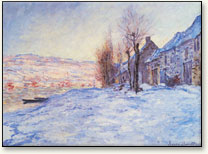Impressionism: The Innovations and Influence
Contemporaries of the first Impressionists used the term “Impressionist” derisively. Why were Impressionists seen as artists who changed accepted concepts on color and light, and why did they challenge later artists to provide even bolder solutions through their work? How, within this framework, did Impressionists develop their own personal manner of depicting their modern world?
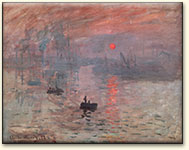
Impression: Sunrise, Claude Monet, 1874. Impressionism takes its name from this painting, one of the initial works exhibited by artists in Paris who were dubbed by critics, “painters of mere impressions.”
Impressionism got its start when several painters began using more natural methods of lighting their work and looking at the world with freshness and immediacy. Their paintings were refused by the official Salon. Because they have certain aims in common, they band together to exhibit, often in a photographer’s Paris studio. The first exhibition, in 1874, featured Claude Monet’s Impression: Sunrise, prompting hostile critics to dismiss them all as
“painters of mere impressions.” The implication is that these artists are incapable of producing a properly composed and finished painting.
An Impressionist paints landscapes and outdoor scenes outside, often working for a very short period of time. Then, as the light changes, the Impressionist stops working, returning on a subsequent day when the light is similar. (See the entry on Monet’s Haystacks.) Although French painters earlier in the century had also confronted a landscape directly, as had the English painter Constable in some of his smaller oil paintings, these artists used more conventional (and therefore acceptable) colors. The Impressionist method of working is made possible by new advances both by the packaging of colors in portable collapsible tubes, and because of the new range of colors available (some less fugitive, and some certainly less poisonous!). While these are important and practical considerations, it is the Impressionist’s vision and method of working that alienates the public.
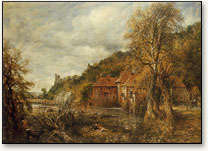
Arundel Mill and Castle, John Constable, 1837.
Although the colors may look conventional today, Constable’s contemporaries found his greens jarringly bright. Because they were used to looking at paintings through a surface dulled by dirt, & discolored varnish, his colors seemed unreal. Reflections on the water became known as “Constable’s Snow.”
In order to capture the ever-changing effects of light on the canvas, the artists paint rapidly, analyzing tone and color at the expense of composition and drawing — held sacred by the Academy. The broken brushstrokes, often just “dabs” of paint, and the high key of color, due in part to colored shadows, also provoke criticism. Likewise, they depart from the norm with their uniform “loading” of the paint surface, when it is accepted tradition to paint shadows thinly. They also paint on white, or very lightly tinted gounds, all of which add to brilliance of color and luminosity. Although a few perceptive collectors, sometimes the color merchants who supplied them, are quick to buy their works, many of these artists did suffer financial hardship. Today, this may seem strange, but many collectors at the time stipulated that commissioned paintings be “toned down” (i.e., given a coat of colored varnish in order to fit with older paintings in their collections.) Constable was criticized for using the greens he saw around him in his landscapes.
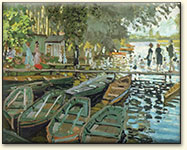
Bathers at La Grenouillère, Claude Monet, 1869. During the summer of 1869, Monet worked with Renoir at this cafe and bathing place on an island in the Seine. He worked with great rapidity to capture the effects of rippling water and sunlight. The light shining on the river and paler color in the distance lead the eye into the landscape, yet the patterned brushwork in the foreground emphasizes the surface of the canvas.
Although a certain group of painters is commonly referred to as “Impressionists,” their aims were not always congruent. Edgar Degas (1834-1917) and some Neo-Impressionists like Georges Seurat (1859-1891) had academic training that they valued (see entry on Pointillism). Pierre-Auguste Renoir (1841-1919), after traveling widely — particularly in Italy — reacts against the apparent “formlessness” of Monet. Paul Cézanne (1839-1906), who exhibits with the Impressionists, criticizes their lack of intellectual rigor, or color “order,” as he chooses to structure his landscapes with directional brushstrokes. Moreover, Vincent van Gogh (1822-1885) is shown in museums with the Impressionists, although he is often referred to as a Realist, Expressionist, or Symbolist. But perhaps this mixture of artists is what makes this subject so interesting and challenging.
Well: there are still people who criticize, even perhaps dislike, some of these paintings, today. Imagine that you are visiting one of these exhibitions in the late 1800’s: how were the paintings shown? (Look at contemporary paintings of Art Exhibitions or an Art Collector’s home!)
How should these paintings be put on display today? Be critical!
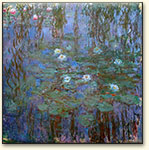
Blue Water Lilies, Claude Monet, |
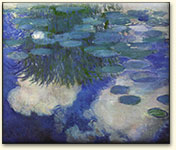
In all of Monet’s paintings, but especially his later works, he draws the eye back to the surface of the painting, often through brushwork independent of form. Artists remind the viewer that they are looking, above all, at a painting; at the artist’s personal vision of an aspect of the real world. |
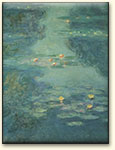
Renoir’s The Umbrellas was possibly started in the late 1870s. The left-hand figures compare with Renoir’s work of around 1885, when he renews his commitment to a sense of structure and greater clarity of form. The fashions illustrated confirm these dates. Yet, he does not sacrifice luminosity or brilliance of color - the left-hand girl’s dress is more smoothly painted but made up of a myriad of hues. |

In any gallery, the Impressionist rooms draw crowds of visitors who respond to the spontaneity and the enjoyment with which Impressionists depicted their world. In some cases, spectators may be misled. For example, Monet’s Bathers at La Grenouillere (1869) has been shown to be a study for a larger painting (now lost), which could well have been painted or finished in his studio. He had a special studio built adjoining his home in order to paint the last Water Lily series, which incorporate patches of color that seem to shimmer and float in water. Likewise, Renoir’s Umbrellas (Les Parapluies) was clearly painted in two stages, the right-hand side in the late 1870s, and the umbrellas and figures on the left about six years later. Nevertheless, Impressionism left a legacy to future artists. The late 19th century artists studied and embraced scientific research into color and light, which informed the development of photography as an artistic medium. |
